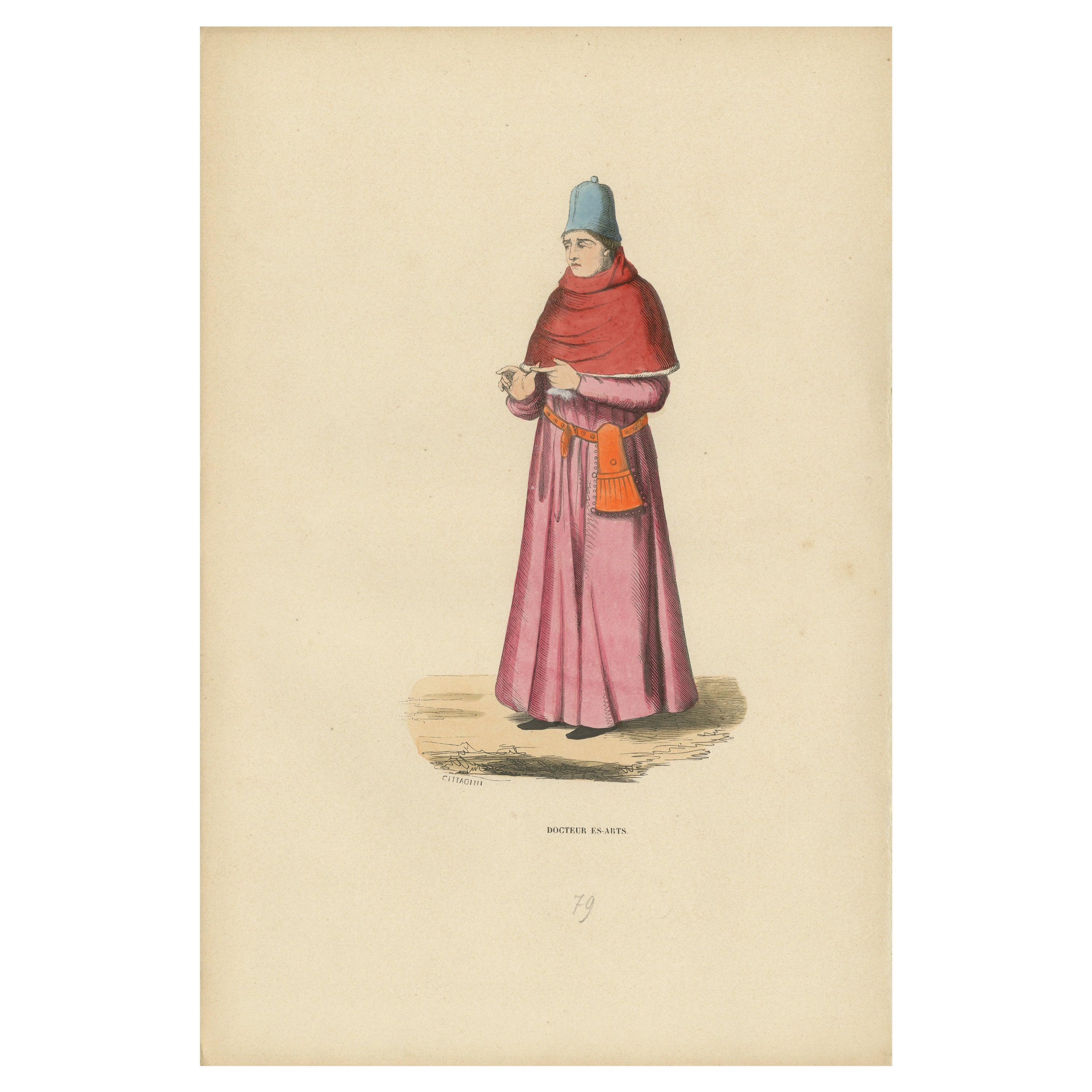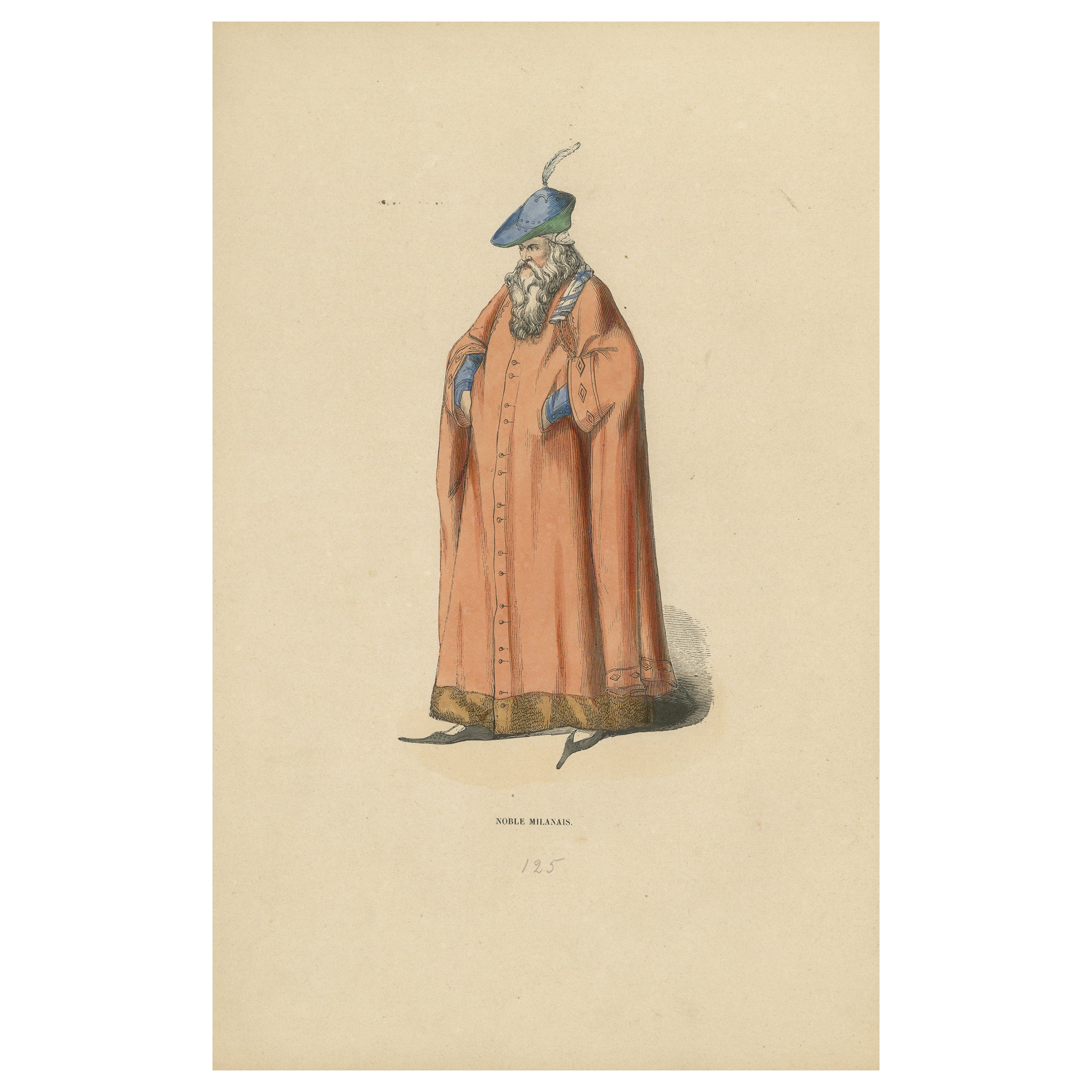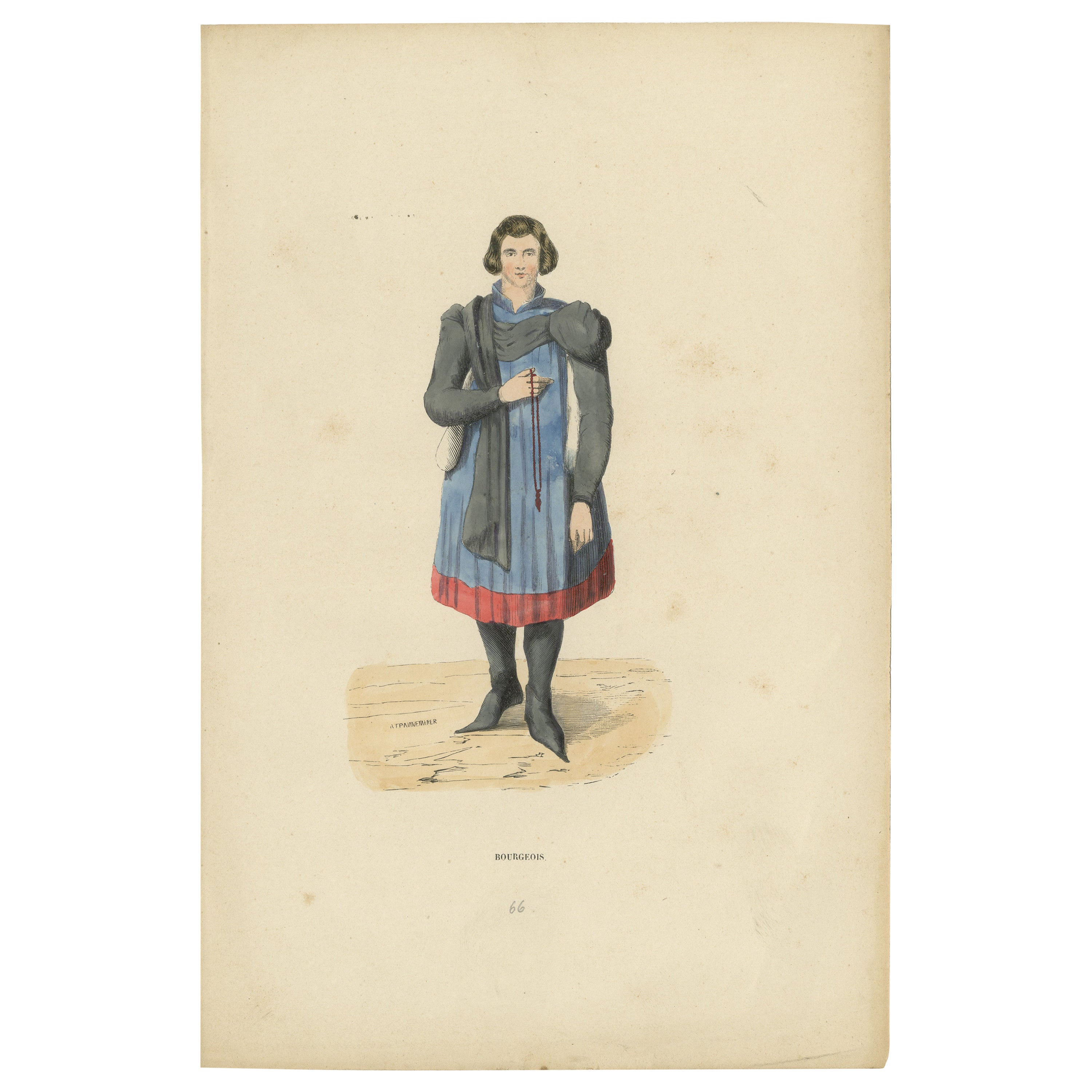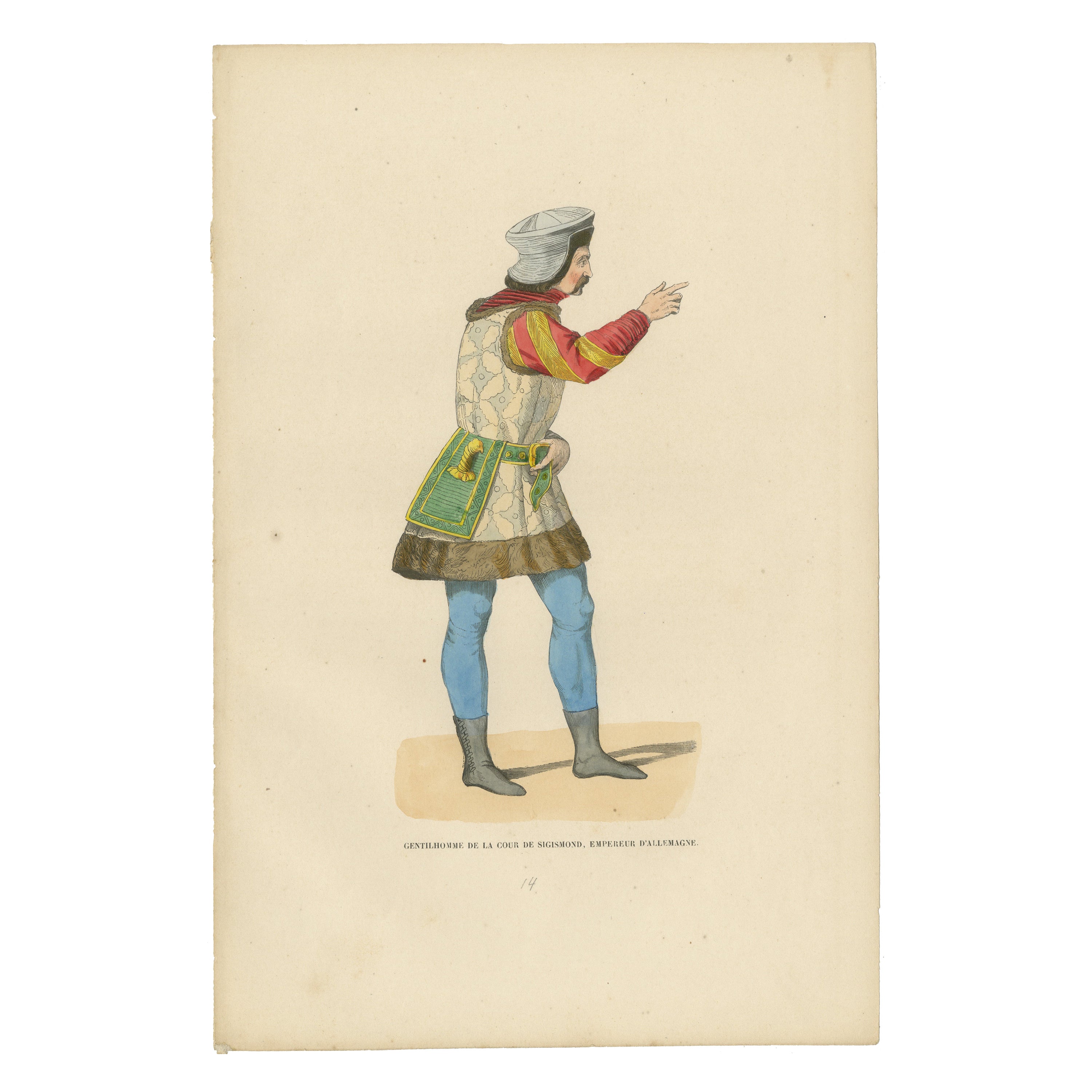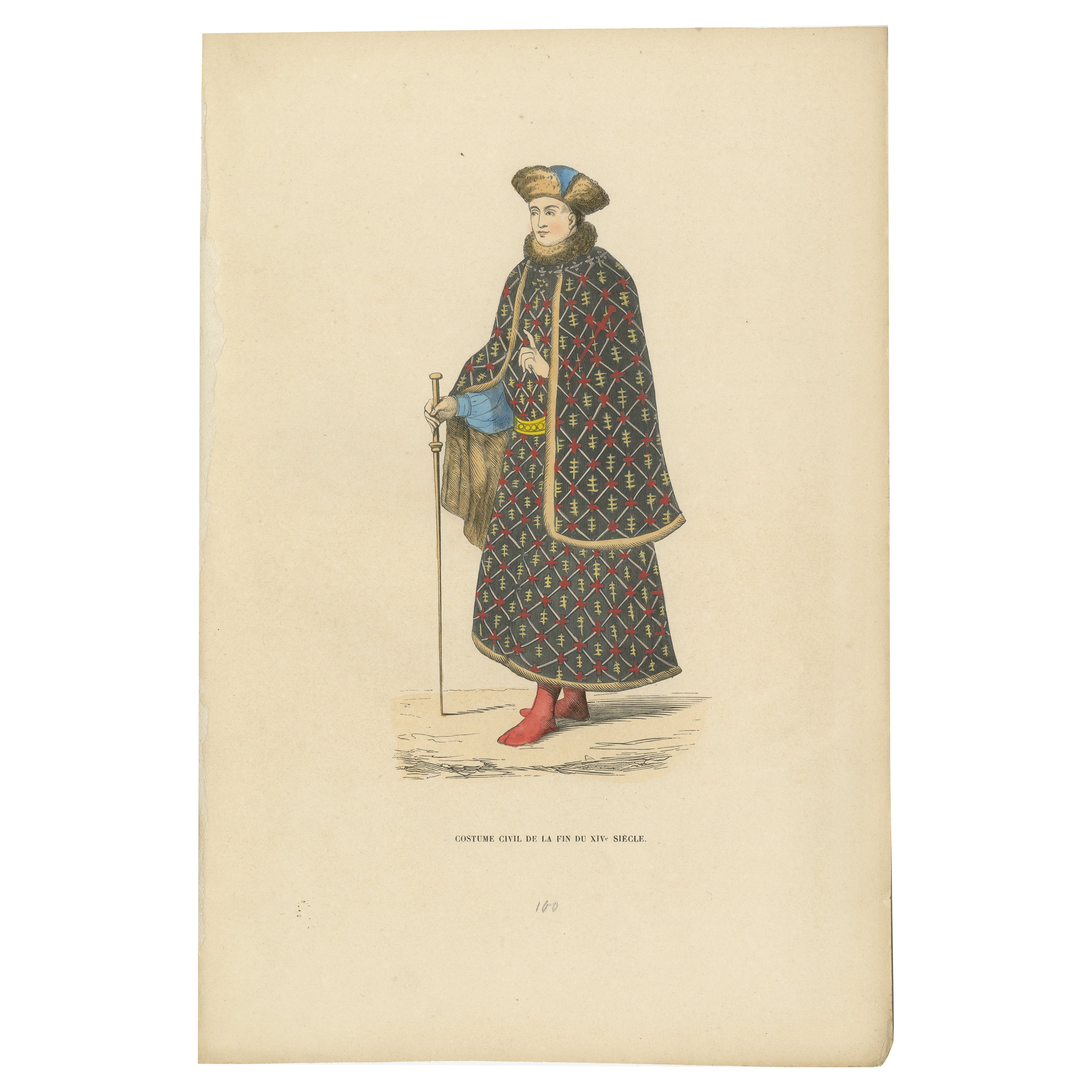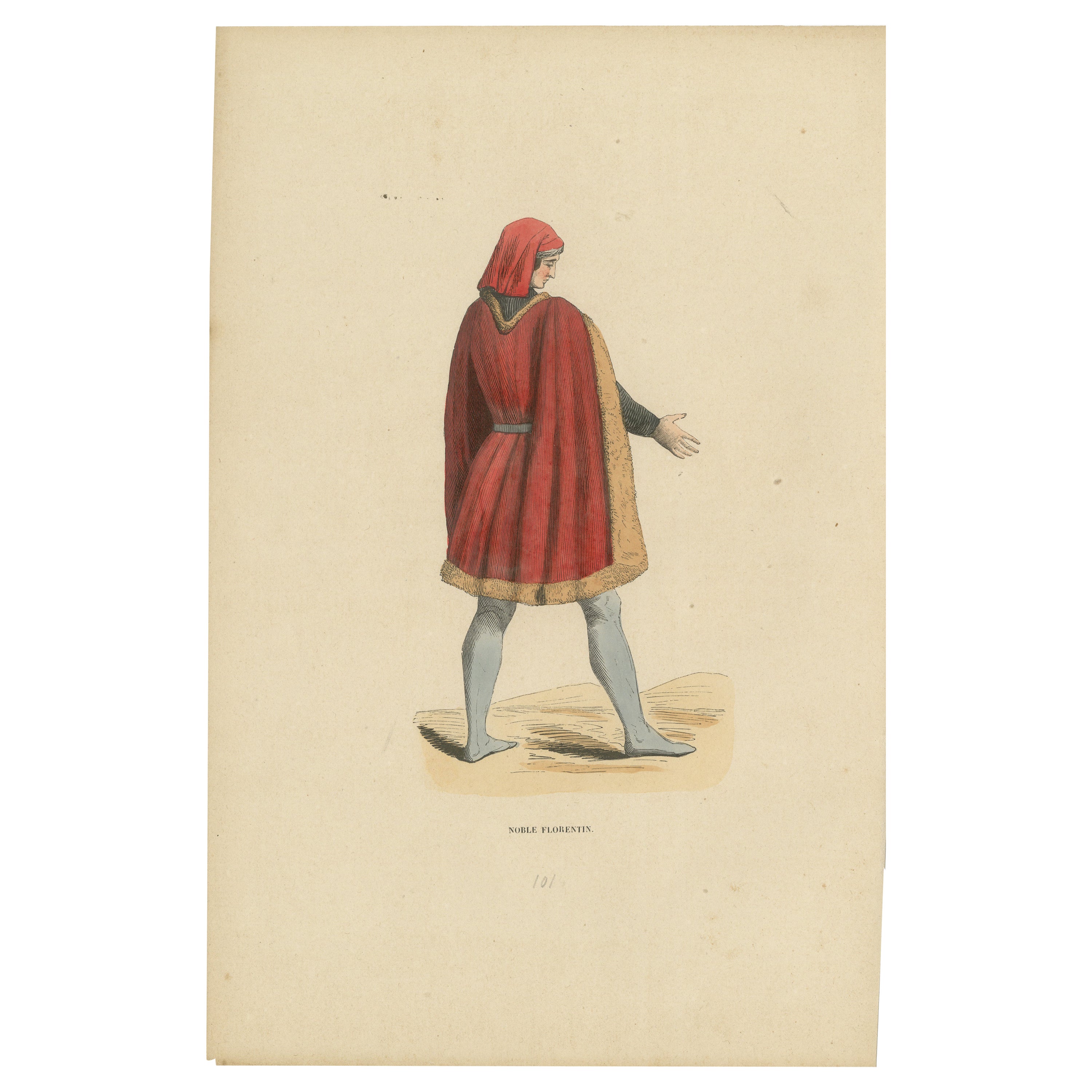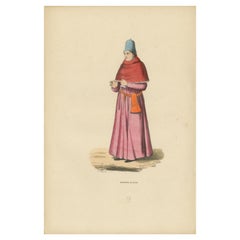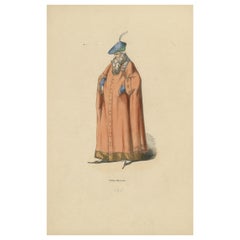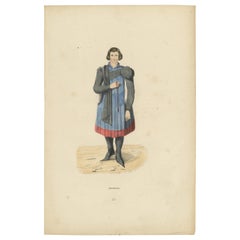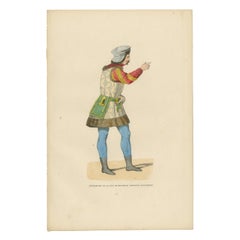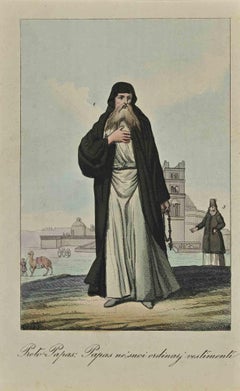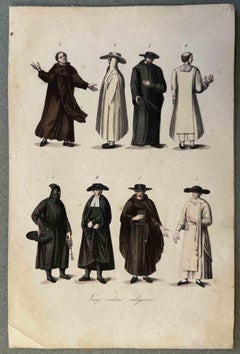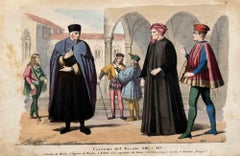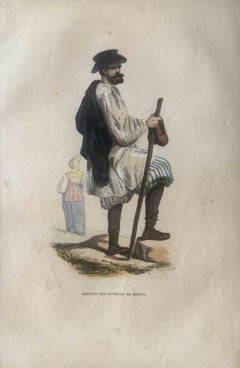Items Similar to The Common Man's Gesture: A Plebeian in Daily Life, 1847
Want more images or videos?
Request additional images or videos from the seller
1 of 7
The Common Man's Gesture: A Plebeian in Daily Life, 1847
$124.71
$155.8920% Off
£92.78
£115.9720% Off
€104
€13020% Off
CA$170.78
CA$213.4720% Off
A$189.88
A$237.3520% Off
CHF 99.15
CHF 123.9320% Off
MX$2,311.31
MX$2,889.1420% Off
NOK 1,265.05
NOK 1,581.3120% Off
SEK 1,185.29
SEK 1,481.6120% Off
DKK 791.69
DKK 989.6220% Off
Shipping
Retrieving quote...The 1stDibs Promise:
Authenticity Guarantee,
Money-Back Guarantee,
24-Hour Cancellation
About the Item
This original antique print for sale shows a figure labeled "Plebeien," which is French for "Plebeian," indicating that this individual is a commoner. The person is depicted in a long, bright yellow robe with a hood, which drapes in wide folds to the ground, a style that might have been worn for warmth or work by common people during certain periods in history.
The individual is gesturing outward with his right hand, perhaps in conversation or pointing towards something of interest. The expression on his face appears engaged and animated. The simplicity of the robe, despite its vibrant color, suggests practical clothing rather than the more ornate attire of the upper classes. The color could signify a particular role within the community, a trade, or simply be a choice of personal attire.
The title suggests the active role of the plebeian within the community and the everyday setting in which he belongs.
Egg whites can be applied as a varnish over pigments to enhance their brightness and to protect the colors. This application could make the colors appear more vivid and also add a slight glossy sheen to the surface of the image.
Egg yolk, on the other hand, was commonly used as a binding agent in paint. It forms the basis of tempera paint, a medium that was widely used before the advent of oil painting. Egg yolk helps to create a durable and long-lasting color that adheres well to various surfaces.
In the context of the print from 1847, it's less likely that egg whites or yolks were used directly on the print, as by that time, commercial printing processes would have been more advanced and less reliant on such manual methods. However, if this print is a representation of an earlier style or is meant to mimic the appearance of hand-painted manuscripts, the original artists might have employed techniques or materials that gave a similar effect to those achieved with egg-based binders and varnishes.
- Dimensions:Height: 10.63 in (27 cm)Width: 7.09 in (18 cm)Depth: 0 in (0.02 mm)
- Materials and Techniques:
- Period:
- Date of Manufacture:1847
- Condition:Good. Overal very light toning and light soiling but the image itself clean and hand-colored almost 200 years ago and still in expliciet colors. Aged paper with typically warm, yellowish-brown hue, mostly around the edges. Study the image carefully.
- Seller Location:Langweer, NL
- Reference Number:Seller: BG-13635-181stDibs: LU3054337886732
About the Seller
5.0
Recognized Seller
These prestigious sellers are industry leaders and represent the highest echelon for item quality and design.
Platinum Seller
Premium sellers with a 4.7+ rating and 24-hour response times
Established in 2009
1stDibs seller since 2017
2,511 sales on 1stDibs
Typical response time: <1 hour
- ShippingRetrieving quote...Shipping from: Langweer, Netherlands
- Return Policy
Authenticity Guarantee
In the unlikely event there’s an issue with an item’s authenticity, contact us within 1 year for a full refund. DetailsMoney-Back Guarantee
If your item is not as described, is damaged in transit, or does not arrive, contact us within 7 days for a full refund. Details24-Hour Cancellation
You have a 24-hour grace period in which to reconsider your purchase, with no questions asked.Vetted Professional Sellers
Our world-class sellers must adhere to strict standards for service and quality, maintaining the integrity of our listings.Price-Match Guarantee
If you find that a seller listed the same item for a lower price elsewhere, we’ll match it.Trusted Global Delivery
Our best-in-class carrier network provides specialized shipping options worldwide, including custom delivery.More From This Seller
View AllScholar of the Arts: The Medieval Academic, 1847
Located in Langweer, NL
Title: "Scholar of the Arts: The Medieval Academic"
Description: This print illustrates a learned individual, likely a doctor of the arts or a scholar, from the medieval period. The...
Category
Antique 1840s Prints
Materials
Paper
$115 Sale Price
20% Off
The Stature of a Milanese Noble: An Lithographic Artistic Depiction, 1847
Located in Langweer, NL
Title: "The Stature of a Milanese Noble: An Artistic Depiction from 'Costume du Moyen Âge'"
Description: This finely detailed lithograph is part of the 1847 seminal work "Costume du Moyen Âge," which portrays a Milanese nobleman, attired in the fashion of the Middle Ages. The nobleman stands in a dignified pose, with a slight turn to the side that suggests movement or the commencement of an address. His garment is a robust, terracotta-hued robe, which falls in heavy folds to the ground, indicating the weight and quality of the fabric. The robe features elegant blue cuffs and a blue collar, which provide a contrast to the warm primary color and are adorned with diamond-shaped embellishments, implying a subtle yet unmistakable wealth.
Atop his head sits a distinctive chapeau with a jaunty feather, adding a touch of personal flair to his ensemble. This hat, along with his full, neatly groomed beard, contributes to the air of wisdom and experience that the nobleman exudes. His expression is one of contemplation and sagacity, with eyes that appear to be observing or assessing the scene before him.
As in other plates from the collection, the background is left intentionally plain, directing the viewer’s focus to the subject and his elaborate attire. This lithograph not only captures the fashion and dignity of a nobleman from Milan but also serves as a cultural and historical record, revealing the meticulous attention to detail in costume design and social hierarchy of the time. The lithograph serves as a visual study of the mores and attire of the period, crafted with reverence for the historical accuracy and an appreciation for the aesthetics of medieval clothing...
Category
Antique 1840s Prints
Materials
Paper
$134 Sale Price
20% Off
Engraving of Medieval Bourgeois: A Portrait of Urban Sophistication, 1847
Located in Langweer, NL
Title: "Medieval Bourgeois: A Portrait of Urban Sophistication"
Description: This print appears to depict a man of the bourgeoisie, the urban middle class, during the medieval perio...
Category
Antique 1840s Prints
Materials
Paper
$115 Sale Price
20% Off
Courtly Splendor: A Nobleman at Emperor Sigismund's Court, 1847
Located in Langweer, NL
The image depicts a man identified as a "Gentilhomme de la cour de Sigismond, empereur d'Allemagne," which translates to "Gentleman of the court of Sigismund, Emperor of Germany."
This individual is portrayed in a profile stance, dressed in attire that is indicative of the high-status courtiers during the time of Emperor Sigismund, who reigned in the early 15th century. He is wearing a turban-like headgear, which reflects the influence of Eastern fashion on European court attire, possibly due to the Ottoman influence or the general exchange of culture during the Crusades and subsequent interactions.
His doublet is richly patterned and he has puffed sleeves in red, which were fashionable among the nobility during the period. The garment is accented with a decorative belt that holds what appears to be a purse or a pouch. He also sports tight blue hose and pointed shoes, which complete the ensemble typical of a nobleman or a high-ranking court official in the Holy Roman Empire.
Egg whites can be applied as a varnish over pigments to enhance their brightness and to protect the colors. This application could make the colors appear more vivid and also add a slight glossy sheen to the surface of the image.
Egg yolk, on the other hand, was commonly used as a binding agent in paint. It forms the basis of tempera paint, a medium that was widely used before the advent of oil painting. Egg yolk helps to create a durable and long-lasting color that adheres well to various surfaces.
In the context of the print from 1847, it's less likely that egg whites or yolks were used directly on the print, as by that time, commercial printing processes would have been more advanced and less reliant on such manual methods. However, if this print is a representation of an earlier style or is meant to mimic the appearance of hand-painted manuscripts...
Category
Antique 1840s Prints
Materials
Paper
$153 Sale Price
20% Off
Civilian Costume at the End of the 15th Century, 1847
Located in Langweer, NL
Title: "Civilian Costume at the End of the 15th Century"
Description: The image is a print from a series the "Costume du Moyen Age" dated 1847, and titled "Costume Civil de la Fin d...
Category
Antique 1840s Prints
Materials
Paper
$172 Sale Price
20% Off
Florentine Nobleman of the Middle Ages, 1847
Located in Langweer, NL
Title: "Civilian Costume at the End of the 15th Century"
Description: The image is a print from a series the "Costume du Moyen Age" dated 1847, and titled "Costume Civil de la Fin du XVe Siècle," which translates to "Civilian Costume at the End of the 15th Century." It showcases a man of status, possibly a noble or a wealthy burgher, standing in a poised and confident manner.
He is attired in an ornate cloak covered in a complex pattern of fleur-de-lis and cross motifs, indicative of wealth and possibly a connection to royalty or high social rank. The cloak is open at the front to reveal a blue doublet with a belt, and he wears red hose—a fashion staple of the late medieval period. His footwear is also red, which stands out against the more subdued tones of his outfit.
On his head, he sports a fur-trimmed hat, adding to the luxuriousness of his attire. In one hand, he holds a long staff, which serves as both a walking aid and a symbol of authority. His other hand rests on the hilt of a dagger, further indicating his readiness to defend his status or engage in the political or civic matters of his time.
The artist has skillfully rendered the textiles and accessories with great care, emphasizing the fashion and social cues of the late 15th-century European society.
The colors have a nice glow over them. Historically, egg whites, known as glair, and sometimes egg yolk were indeed used in illumination and painting, particularly in manuscripts, to give colors a brighter appearance and to add a sheen or gloss to the work. This technique was quite common during the Middle Ages...
Category
Antique 1840s Prints
Materials
Paper
$124 Sale Price
20% Off
You May Also Like
Uses and Customs - Papas - Lithograph - 1862
Located in Roma, IT
Uses and Customs - Papas is a lithograph on paper realized in 1862.
The artwork belongs to the Suite Uses and customs of all the peoples of the universe: " History of the government...
Category
1860s Modern Figurative Prints
Materials
Lithograph
Uses and Customs - Various Religion Orders - Lithograph - 1862
Located in Roma, IT
Uses and Customs - Various Religion Orders is a lithograph on paper realized in 1862.
The artwork belongs to the Suite Uses and customs of all the peoples of the universe: " History...
Category
1860s Modern Figurative Prints
Materials
Lithograph
Uses and Customs - 13th and 14th Century - Lithograph - 1862
Located in Roma, IT
Uses and Customs - 13th and 14th Century is a lithograph on paper realized in 1862.
The artwork belongs to the Suite Uses and customs of all the peoples of the universe: " History o...
Category
1860s Modern Figurative Prints
Materials
Lithograph
Uses and Customs - Man From Moscow - Lithograph - 1862
Located in Roma, IT
Uses and Customs - Man From Moscow is a lithograph on paper realized in 1862.
The artwork belongs to the Suite Uses and customs of all the peoples of the universe: " History of the ...
Category
1860s Modern Figurative Prints
Materials
Lithograph
Eleuthe - Lithograph by Auguste Wahlen - 1844
Located in Roma, IT
Eleuthe is a lithograph made by Auguste Wahlen in 1844.
Hand colored.
Good condition.
At the center of the artwork is the original title "Eleuthe".
The work is part of Suite Moeu...
Category
1840s Modern Figurative Prints
Materials
Lithograph
Figure - Costumes - Lithograph - 1862
Located in Roma, IT
Figure - Costumes is a Hand-colored lithograph on paper realized in 1862.
The artwork belongs to the Suite Uses and customs of all the peoples of the universe: " History of the gove...
Category
1860s Modern Figurative Prints
Materials
Lithograph
More Ways To Browse
American Biedermeier
Antique Burled Walnut Chest Of Drawers
Antique Comb Case
Antique Copper Bowl With Handles
Antique French Filing Cabinet
Antique Frock Coat
Antique Germany Creamer
Antique Glass Canisters
Antique Glass Powder Boxes
Antique Horse Wagon
Antique Hunting Accessories
Antique Hunting Pack
Antique Metal Rooster
Antique Metal Tea Pot
Antique Necessaire
Antique Pie Case
Antique Pill Box Gold
Antique Sake Set
